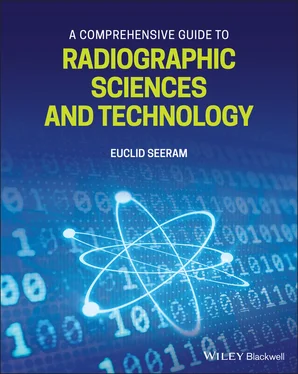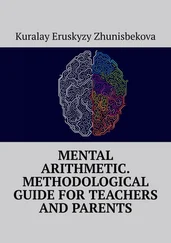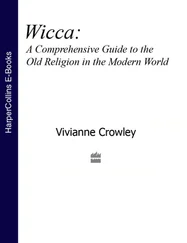Dr Robert Davidson, PhD, MAppSc (MI), BBus, FASMIRT
Professor of Medical Imaging, Faculty of Health, University of Canberra, ACT, Australia
Radiographic sciences and technology include a wide range of topics essential for radiography/radiological technology curriculum offered by educational institutions (colleges, universities, and institutes of technology) around the world. Additionally, radiography/radiological technology/medical imaging professional organizations for radiographer/technologist education and training, such as, for example, the American Association of Radiologic Technologists (ASRT) and the Canadian Association of Medical Radiation Technologists (CAMRT) offer curriculum guidelines for educational institutions to use as guiding principles for core clinical competencies. More details of related activities are highlighted in Chapter 1.
This book includes 13 chapters organized into 6 sections as follows:
Section 1: Chapters 1and 2
Section 2: Basic Radiographic Sciences and Technology
Section 3: Computed Tomography: Basic Physics and Technology
Section 4: Continuous Quality Improvement
Section 5: Picture Archiving and Communications Systems (PACS) and Imaging Informatics
Section 6: Radiation Protection
The purpose of this book, A Comprehensive Guide to Radiographic Sciences and Technology , is to provide an essential and practical guide for students and technologists engaged in the study and practice of radiography/radiological technology. One of its primary goals is to provide a resource that is brief, clear, and a concise coverage of the subject in preparation for final examinations as well as professional certification examinations. This book is not a textbook as such, and it is not intended to replace the vast resources on radiographic sciences and technology. Rather, it provides a précis of the extensive coverage of radiographic sciences and technical system components for students and technologists.
On the successful completion of the chapters in this book, the reader will be able to:
1 Outline the core subject matter content of radiographic imaging modalities.
2 Identify and describe briefly the major technical components of digital radiographic imaging systems.
3 Outline the basic physics necessary for understanding essential concepts and principles for x‐ray generation, production, x‐ray emission, x‐ray interaction with matter, and radiation attenuation in the production of diagnostic images in clinical practice.
4 Describe the major components of the x‐ray generator and x‐ray tube including heat capacity and heat dissipation and x‐ray beam filtration and collimation.
5 Explain the core principles of digital image processing, including the characteristics of the digital image and common image processing operations applied in practice.
6 Identify and explain the fundamental physics principles and technology of the following digital imaging modalities: computed radiography (CR), flat‐panel digital radiography (FPDR), and digital fluoroscopy.
7 Identify image quality metrics and explain each of them with a focus on how dose is linked to image quality.
8 Describe the basic physics of computed tomography (CT) and explain the major technological considerations of multislice CT (MSCT), including image post processing, image quality metrics, and radiation protection considerations in CT.
9 Identify the essential elements of quality control (QC), including the principles of a repeat analysis, and describe the performance criteria for common QC tests for radiography, fluoroscopy, and CT.
10 Describe the core technical components of PACS, and explain briefly the general subject matter comprising imaging informatics, including artificial intelligence and its subsets: machine learning and deep learning.
11 Outline the major principles of radiobiology, with a specific focus on relevant physical processes, dose–response models, stochastic and deterministic effects, as well as radiation effects on the conceptus.
12 Explain the technical factors affecting the dose in radiography, fluoroscopy, and CT.
13 Identify and discuss the major components of radiation protection including radiation protection philosophy of the International Commission on Radiological Protection (ICRP), radiation quantities and units, personnel dosimetry, optimization of radiation protection, and the current state of gonadal shielding.
USE OF THESE OBJECTIVES AND CONTENT
These objectives and content covered in this book may be used in the following subjects covered in standard radiography/radiological technology programs:
1 Physics of Radiography
2 Digital Radiography Equipment Including Digital Fluoroscopy
3 Image Quality
4 PACS and Imaging Informatics
5 Quality Control in Radiography and Fluoroscopy
6 Computed Tomography Physics and Instrumentation for Entry to Practice
7 Radiobiology for Diagnostic Radiography
8 Radiation Protection in Diagnostic Radiography
Chapter 1introduces the nature and scope of radiographic sciences and technology and sets the general framework for the remaining chapters. Whereas Chapter 2presents a description of the major technical components of digital radiographic imaging modalities, such as computed radiography (CR), FPDR, digital fluoroscopy, and digital mammography, Chapter 3describes the essential physics of radiography, including principles for x‐ray generation, production, x‐ray emission, x‐ray interaction with matter, and radiation attenuation in the production of diagnostic images in clinical practice. Chapter 4examines the major technical components of the x‐ray generator and x‐ray tube, describing core technologies such as the x‐ray circuit, x‐ray generators, the structure and function of the x‐ray tube, heat capacity and dissipation, as well as the nature of x‐ray beam filtration and collimation. Chapter 5reviews the fundamental elements of digital image processing beginning with a definition, followed by a review of image formation and representation, processing operations, characteristics of digital images, and gray‐scale processing, most notably the nature of windowing. Chapters 6and 7address the principles and technology of digital radiographic imaging modalities, identified in Chapter 2, and image quality and dose, respectively. Chapter 8covers the essential technical aspects of CT, at a depth needed for entry‐to‐practice, including the basic physics and technology of CT. Specifically, the major technical system components of MSCT are described. Furthermore, image processing, image quality, and radiation dose and radiation protection are described. Chapter 9provides a discussion of quality control and focusses on the performance criteria/tolerance limits for common QC tests for radiography, fluoroscopy, and CT tests that are in the domain of the technologist. Finally, the chapter reviews the elements of repeat image analysis. The nature of imaging informatics including major topics as picture archiving and communication systems (PACS), and specific imaging topics such as enterprise imaging, cloud computing, Big Data, and artificial intelligence, and its subsets, machine learning and deep learning, are reviewed in Chapter 10. Finally, Section 6covers topics in radiation protection. In particular, while Chapter 11provides a discussion of basic concepts of radiobiology, Chapter 12deals with the technical dose factors in radiography, fluoroscopy, and CT. Finally, the book concludes with Chapter 13, which addresses the essential principles of radiation protection, focusing on topics such as a rationale for radiation protection, objectives of radiation protection, radiation protection philosophy of the International Commission on Radiological Protection (ICRP), radiation quantities and units, personnel dosimetry, optimization of radiation protection, and the current state of gonadal shielding.
Читать дальше











